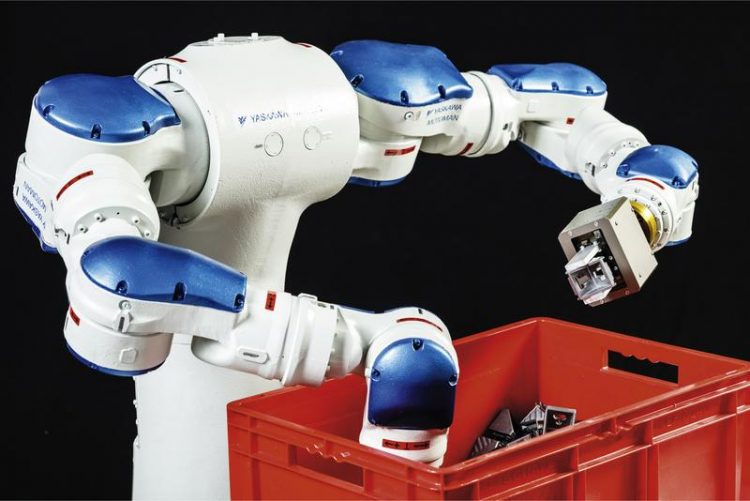New two-armed robot system for bin picking

New two-armed robot system for fast bin picking. source: Fraunhofer IPA
The system has two arms. Using the “bp3™” software for bin picking developed by Fraunhofer IPA, the system is capable of detecting and localizing objects, computing the appropriate grasping points and planning how to remove the part from the bin without collision.
The two-armed robot can alternately pick components from the bin and, if necessary, even grip and put them down accurately with its second arm. This allows cycle times to be significantly reduced. At Automatica 2014, scientists from Fraunhofer IPA will demonstrate how to pick components quickly and safely from a bin.
Custom-made consumer goods, falling product lifetimes and short development cycles: the challenges facing manufacturing industry are considerable. At present, bulk parts in bins are mostly unloaded by hand or sorted by machine. This leads to physical stress on employees and high costs for different workpiece-holding fixtures.
In addition, mechanized sorting using vibratory bowls or conveyors is usually suitable only for small parts and is not very flexible. Therefore, to reduce cycle times, to increase the degree of automation and thus to safeguard their competitiveness, many customers have expressed a wish for versatile sorting robots: fast, flexible and reliable, they relieve the pressure on employees while at the same time cutting costs.
Scientists from Fraunhofer IPA have developed a new automated sorting and feeding system that meets these requirements. What’s new about the robot system? It has two arms. “A key advantage of the two-armed robot is that it can grasp and remove chaotically arranged parts alternately and therefore faster from the bin.
This allows companies to employ bin picking e.g. also for the feeding of small parts, an area where it has conventionally often been impossible to achieve the required cycle times,” explains Felix Spenrath, Project Manager in the Robot and Assistive Systems department. “Taking the example of picking components from small load carriers, at Automatica 2014 we will for the first time demonstrate how the new two-armed feeding system works,” says Spenrath.
Collision-free and safe path planning
The “bp3TM” software developed at Fraunhofer IPA stands for the already proven BinPicking3d. Picking is planned using a stationary or robot-controlled 3D sensor, the software allowing automated bin picking by robots or other handling kinematics for any application. In less than a second, the 3D sensor is able to capture the situation in the bin and to localize components in the bin. Next, the system computes which component can be removed without the gripper colliding with the edge of the bin or with other objects. Simulation of the picking process makes a key contribution to the high reliability of the system as a whole.
The “bp3TM” software offers a number of advantages: it is compatible with several sensor types and robots and can be used for different component geometries. “In its simplest version, the software system is preconfigured for the application by Fraunhofer IPA. Experienced users and system integrators have the option of themselves expanding the system at little cost to handle new components and adapting it to meet new situations,” says Spenrath. The system is also user-friendly. After just a short period of training, users are able to work with the system without problem. In addition, the system can be quickly taught to handle new components.
More at Automatica – 6th International Trade Fair for Automation and Mechatronics
3 to 6 June 2014
New Trade Fair Centre Munich
Hall A4 | Stand 530
Contact
Dipl.-Inf. Felix Spenrath, phone +49 711 970-1037, felix.spenrath@ipa.fraunhofer.de
http://www.automatica-munich.com
http://www.ipa.fraunhofer.de
Media Contact
All latest news from the category: Trade Fair News
Newest articles

Security vulnerability in browser interface
… allows computer access via graphics card. Researchers at Graz University of Technology were successful with three different side-channel attacks on graphics cards via the WebGPU browser interface. The attacks…

A closer look at mechanochemistry
Ferdi Schüth and his team at the Max Planck Institut für Kohlenforschung in Mülheim/Germany have been studying the phenomena of mechanochemistry for several years. But what actually happens at the…

Severe Vulnerabilities Discovered in Software to Protect Internet Routing
A research team from the National Research Center for Applied Cybersecurity ATHENE led by Prof. Dr. Haya Schulmann has uncovered 18 vulnerabilities in crucial software components of Resource Public Key…





















